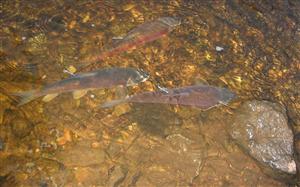Aquatic Organisms: Vertebrates
All animals that have a backbone are called vertebrates. They are generally the most familiar of animals, and include fish, amphibians, reptiles, mammals, and birds.
Fish
Fish display every major feeding type: herbivorous fish feed on periphyton or macrophytes, or may even filter phytoplankton from the water; carnivorous fish feed on molluscs, worms, insects, zooplankton, and other fish; omnivorous fish may feed on specific types of prey, or feed indiscriminately on nearly anything they can consume. Due to this diversity in modes of feeding, different fish can occupy very different places in a food web.
As with feeding behaviour, some fish occupy very specific habitats while others can be found in a wide variety of lakes and rivers. The distribution of fish can be influenced by a large number of factors, including oxygen concentration, temperature, the presence of macrophytes, the availability of suitable substrate for spawning, and current speed (in streams and rivers). Changes in fish habitat (such as reduction of flooding due to damming) can favour some types of fish, and disadvantage others.
For more information on the fishes of lower Athabasca River, view the Interactive Fish Catalogue.
Amphibians
Amphibians are cold-blooded vertebrates that generally live out their juvenile stages in aquatic environments and then move onto land as adults; however, some amphibians remain aquatic for their entire life. The most familiar amphibians are frogs, toads, and salamanders.
When amphibians transform from juvenile to adult, they often undergo a significant change in diet. Tadpoles, for example, are usually herbivorous, consuming periphyton or macrophytes, but adult frogs are carnivorous, feeding on animals such as insects, worms, snails, or nearly any other animal that they are capable of swallowing whole. Frog tadpoles are an important food source for some fish. In addition, aquatic birds and some reptiles (such as aquatic snakes) prey upon the adults.
Due to the dependence of amphibians on water and warmer temperatures, they are most active in the summer and often hibernate on land in the winter.
Reptiles
Unlike amphibians, reptiles are largely a terrestrial group of animals. In the oil sands region, they include turtles and snakes. As they are also cold blooded, reptiles depend on environmental conditions to regulate their body temperature.
Reptiles lay eggs on land and it must be warm enough for eggs to hatch and grow. Reptiles are more active in the summer months when temperatures permit and they often hibernate during the winter. Reptiles have a thick skin that allows them to tolerate dry conditions and are not as dependent on water as amphibians are. However, some reptiles spend large amounts of time in water and feed there. Most reptiles, including those that feed in fresh water, are predatory and capture a variety of prey.









